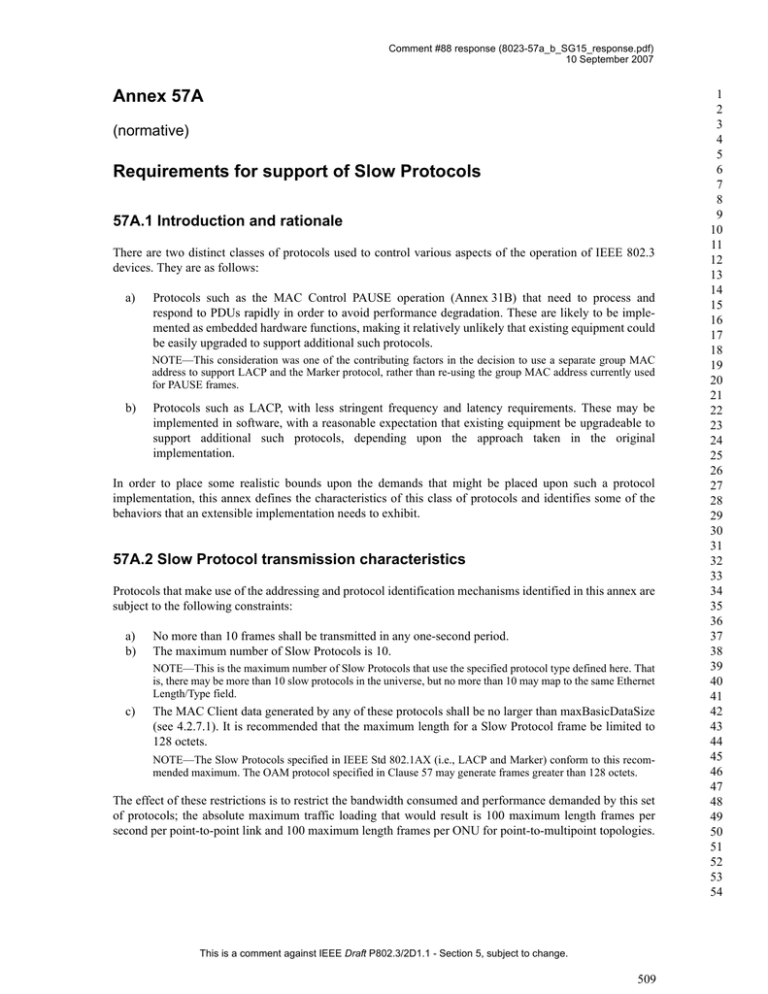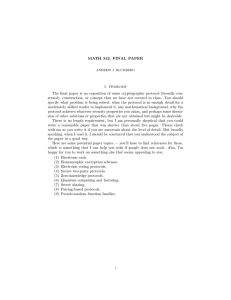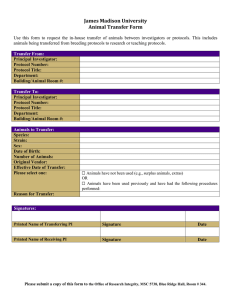Annex 57A Requirements for support of Slow Protocols
advertisement

Comment #88 response (8023-57a_b_SG15_response.pdf) 10 September 2007 Annex 57A (normative) Requirements for support of Slow Protocols 57A.1 Introduction and rationale There are two distinct classes of protocols used to control various aspects of the operation of IEEE 802.3 devices. They are as follows: a) Protocols such as the MAC Control PAUSE operation (Annex 31B) that need to process and respond to PDUs rapidly in order to avoid performance degradation. These are likely to be implemented as embedded hardware functions, making it relatively unlikely that existing equipment could be easily upgraded to support additional such protocols. NOTE—This consideration was one of the contributing factors in the decision to use a separate group MAC address to support LACP and the Marker protocol, rather than re-using the group MAC address currently used for PAUSE frames. b) Protocols such as LACP, with less stringent frequency and latency requirements. These may be implemented in software, with a reasonable expectation that existing equipment be upgradeable to support additional such protocols, depending upon the approach taken in the original implementation. In order to place some realistic bounds upon the demands that might be placed upon such a protocol implementation, this annex defines the characteristics of this class of protocols and identifies some of the behaviors that an extensible implementation needs to exhibit. 57A.2 Slow Protocol transmission characteristics Protocols that make use of the addressing and protocol identification mechanisms identified in this annex are subject to the following constraints: a) b) No more than 10 frames shall be transmitted in any one-second period. The maximum number of Slow Protocols is 10. NOTE—This is the maximum number of Slow Protocols that use the specified protocol type defined here. That is, there may be more than 10 slow protocols in the universe, but no more than 10 may map to the same Ethernet Length/Type field. c) The MAC Client data generated by any of these protocols shall be no larger than maxBasicDataSize (see 4.2.7.1). It is recommended that the maximum length for a Slow Protocol frame be limited to 128 octets. NOTE—The Slow Protocols specified in IEEE Std 802.1AX (i.e., LACP and Marker) conform to this recommended maximum. The OAM protocol specified in Clause 57 may generate frames greater than 128 octets. The effect of these restrictions is to restrict the bandwidth consumed and performance demanded by this set of protocols; the absolute maximum traffic loading that would result is 100 maximum length frames per second per point-to-point link and 100 maximum length frames per ONU for point-to-multipoint topologies. This is a comment against IEEE Draft P802.3/2D1.1 - Section 5, subject to change. 509 1 2 3 4 5 6 7 8 9 10 11 12 13 14 15 16 17 18 19 20 21 22 23 24 25 26 27 28 29 30 31 32 33 34 35 36 37 38 39 40 41 42 43 44 45 46 47 48 49 50 51 52 53 54 Comment #88 response (8023-57a_b_SG15_response.pdf) 10 September 2007 57A.3 Addressing The Slow_Protocols_Multicast address has been allocated exclusively for use by Slow Protocols PDUs; its value is identified in Table 57A–1. Table 57A–1—Slow_Protocols_Multicast address Name Value Slow_Protocols_Multicast address 01-80-C2-00-00-02 NOTES 1—This address is within the range reserved by ISO/IEC 15802-3 (MAC Bridges) for link-constrained protocols. As such, frames sent to this address will not be forwarded by conformant MAC Bridges; its use is restricted to a single link. 2—Although the two currently existing Slow Protocols (i.e., LACP and the Marker protocol) always use this MAC address as the destination address in transmitted PDUs, this may not be true for all Slow Protocols. In some yet-to-bedefined protocol, unicast addressing may be appropriate and necessary. Rather, the requirement is that this address not be used by any protocols that are not Slow Protocols. 57A.4 Protocol identification All Slow Protocols use Type-field encoding of the Length/Type field, and use the Slow_Protocols_Type value as the primary means of protocol identification; its value is shown in Table 57A–2. Table 57A–2—Slow_Protocols_Type field Name Slow_Protocols_Type field Value 88-09 The first octet of the MAC Client data following the Length/Type field is a protocol subtype identifier that distinguishes between different Slow Protocols. Table 57A–3 identifies the semantics of this subtype. NOTE—Although this mechanism is defined as part of an IEEE 802.3 standard, it is the intent that the reserved code points in this table will be made available to protocols defined by other working groups within IEEE 802, should this mechanism be appropriate for their use. 57A.5 Handling of Slow Protocol frames Any received MAC frame that carries the Slow_Protocols_Type field value is assumed to be a Slow Protocol frame. An implementation that claims conformance to this standard shall handle all Slow Protocol frames as follows: a) Discard any Slow Protocol frame that carries an illegal value of Protocol Subtype (see Table 57A–3). Such frames shall not be passed to the MAC Client. b) Pass any Slow Protocol frames that carry Protocol Subtype values that identify supported Slow Protocols to the protocol entity for the identified Slow Protocol. This is a comment against IEEE Draft P802.3/2D1.1 - Section 5, subject to change. 510 1 2 3 4 5 6 7 8 9 10 11 12 13 14 15 16 17 18 19 20 21 22 23 24 25 26 27 28 29 30 31 32 33 34 35 36 37 38 39 40 41 42 43 44 45 46 47 48 49 50 51 52 53 54 Comment #88 response (8023-57a_b_SG15_response.pdf) 10 September 2007 Table 57A–3—Slow Protocols subtypes Protocol Subtype value 0 Unused—Illegal value 1 Link Aggregation Control Protocol (LACP) 2 Link Aggregation—Marker Protocol 3 Operations, Administration, and Maintenance (OAM) 4 Reserved for future use 5 Reserved for future use 6 Reserved for future use 7 Reserved for future use 8 Reserved for future use 9 Reserved for future use 10 Organization Specific Slow Protcol (OSSP) 11–255 c) Protocol name Unused—Illegal values Pass any Slow Protocol frames that carry Protocol Subtype values that identify unsupported Slow Protocols to the MAC Client. NOTE—The intent of these rules is twofold. First, they rigidly enforce the maximum number of Slow Protocols, ensuring that early implementations of this mechanism do not become invalidated as a result of “scope creep.” Second, they make it clear that the appropriate thing to do in any embedded frame parsing mechanism is to pass frames destined for unsupported protocols up to the MAC Client rather than discarding them, thus allowing for the possibility that, in soft configurable systems, the MAC Client might be enhanced in the future in order to support protocols that were not implemented in the hardware. This is a comment against IEEE Draft P802.3/2D1.1 - Section 5, subject to change. 511 1 2 3 4 5 6 7 8 9 10 11 12 13 14 15 16 17 18 19 20 21 22 23 24 25 26 27 28 29 30 31 32 33 34 35 36 37 38 39 40 41 42 43 44 45 46 47 48 49 50 51 52 53 54 Comment #88 response (8023-57a_b_SG15_response.pdf) 10 September 2007 57A.6 Protocol implementation conformance statement (PICS) proforma for Annex 57A, Requirements for support of Slow Protocols1 57A.6.1 Introduction The supplier of an implementation that is claimed to conform to Annex 57A shall complete the following protocol implementation conformance statement (PICS) proforma. A detailed description of the symbols used in the PICS proforma, along with instructions for completing the PICS proforma, can be found in Clause 21. 57A.6.2 Identification 57A.6.2.1 Implementation identification Supplier (Note 1) Contact point for queries about the PICS (Note 1) Implementation Name(s) and Version(s) (Notes 1 and 3) Other information necessary for full identification— e.g., name(s) and version(s) of machines and/or operating system names (Note 2) NOTES 1—Required for all implementations. 2—May be completed as appropriate in meeting the requirements for the identification. 3—The terms Name and Version should be interpreted appropriately to correspond with a supplier’s terminology (e.g., Type, Series, Model). 57A.6.2.2 Protocol summary Identification of protocol specification IEEE Std 802.3-200X, Annex 57A, Requirements for support of Slow Protocols. Identification of amendments and corrigenda to the PICS proforma that have been completed as part of the PICS Have any Exception items been required? No [ ] Yes [ ] (See Clause 21: the answer Yes means that the implementation does not conform to IEEE Std 802.3-200X, Annex 57A, Requirements for support of Slow Protocols.) Date of Statement 1 Copyright release for PICS proformas: Users of this standard may freely reproduce the PICS proforma in this annex so that it can be used for its intended purpose and may further publish the completed PICS. This is a comment against IEEE Draft P802.3/2D1.1 - Section 5, subject to change. 512 1 2 3 4 5 6 7 8 9 10 11 12 13 14 15 16 17 18 19 20 21 22 23 24 25 26 27 28 29 30 31 32 33 34 35 36 37 38 39 40 41 42 43 44 45 46 47 48 49 50 51 52 53 54 Comment #88 response (8023-57a_b_SG15_response.pdf) 10 September 2007 57A.6.2.3 Transmission characteristics Item Feature Subclause Value/Comment Status Support SP1 Transmission rate 57A.2 Max 10 frames in any one-second period M Yes [ ] SP2 Data field 57A.2 No larger than maxBasicDataSize (see 4.2.7.1) M Yes [ ] Status Support M Yes [ ] 57A.6.2.4 Frame handling Item FH1 Feature Handling of Slow Protocol frames Subclause 57A.5 Value/Comment As specified in 57A.5 This is a comment against IEEE Draft P802.3/2D1.1 - Section 5, subject to change. 513 1 2 3 4 5 6 7 8 9 10 11 12 13 14 15 16 17 18 19 20 21 22 23 24 25 26 27 28 29 30 31 32 33 34 35 36 37 38 39 40 41 42 43 44 45 46 47 48 49 50 51 52 53 54 Comment #88 response (8023-57a_b_SG15_response.pdf) 10 September 2007 Annex 57B (normative) Organization specific slow protocol (OSSP) The organization specific slow protocol (OSSP) provides a standardized means for organizations to define their own slow protocols outside the scope of this standard. The requirements defined in Annex 57A apply to these slow protocols. 57B.1 Transmission and representation of octets An organization specific slow protocol data unit (OSSPDU) comprises an integral number of octets. The bits in each octet are numbered from 0 to 7, where 0 is the low-order bit. When consecutive octets are used to represent a numerical value, the most significant octet is transmitted first, followed by successively less significant octets. 57B.1.1 OSSPDU frame structure The OSSPDU frame structure shall be as depicted in Figure 57B–1. In this figure: a) b) c) d) Octets are transmitted from top to bottom. Within an octet, bits are shown with bit 0 to the left and bit 7 to the right, and are transmitted from left to right. When consecutive octets are used to represent a binary number, the octet transmitted first has the more significant value. When consecutive octets are used to represent a MAC address, the least significant bit of the first octet is assigned the value of the first bit of the MAC address, the next most significant bit the value of the second bit of the MAC address, and so on through the eighth bit. Similarly the least significant through most significant bits of the second octet are assigned the value of the ninth through seventeenth bits of the MAC address, and so on for all the octets of the MAC address. A OSSPDU shall have the following fields: a) Destination Address (DA). The DA in OSSPDUs is the Slow_Protocols_Multicast address. Its use and encoding are specified in Annex 57A. b) Source Address (SA). The SA in OSSPDUs is the individual MAC address associated with the port through which the OSSPDU is transmitted. c) Length/Type. OSSPDUs are Type encoded, and carry the Slow_Protocols_Type field value. The use and encoding of this type is specified in Annex 57A. d) Subtype. The Subtype field identifies the specific Slow Protocol being encapsulated. OSSPDUs carry the Subtype value 0x0A as specified in Annex 57A. e) Organizationally Unique Identifier (OUI). The OUI field contains the Organizationally Unique Identifier (OUI) to identify the Organization Specific Data. The bit/octet ordering of the Organizationally Unique Identifier field within an OSSPDU is identical to the bit/octet ordering of the OUI portion of the DA/SA. Organization Specific Data. The format and function of the Organization Specific Data field is dependent on the value of the OUI field and is beyond the scope of this standard. OSSPDUs are at least minFrameSize in length. f) This is a comment against IEEE Draft P802.3/2D1.1 - Section 5, subject to change. 514 1 2 3 4 5 6 7 8 9 10 11 12 13 14 15 16 17 18 19 20 21 22 23 24 25 26 27 28 29 30 31 32 33 34 35 36 37 38 39 40 41 42 43 44 45 46 47 48 49 50 51 52 53 54 Comment #88 response (8023-57a_b_SG15_response.pdf) 10 September 2007 g) FCS. This field is the Frame Check Sequence, typically generated by the underlying MAC. 1 2 3 4 5 6 7 8 9 10 11 12 13 14 15 16 17 18 19 20 21 22 23 24 25 26 27 28 29 30 31 32 33 34 35 36 37 38 39 40 41 42 43 44 45 46 47 48 49 50 51 52 53 54 Octets Destination Address 6 Source Address 6 Length/Type 2 Subtype = 0x0A (OSS) 1 Organizationally Unique Identifier 3 Organization Specific Data 42 - 1496 FCS 4 LSB OCTETS WITHIN FRAME TRANSMITTED TOP-TO-BOTTOM MSB b0 b7 BITS WITHIN FRAME TRANSMITTED LEFT-TO-RIGHT Table 57B–1—OSSPDU structure This is a comment against IEEE Draft P802.3/2D1.1 - Section 5, subject to change. 515 Comment #88 response (8023-57a_b_SG15_response.pdf) 10 September 2007 57B.2 Protocol implementation conformance statement (PICS) proforma for Annex 57B, Organization specific slow protocol (OSSP)2 57B.2.1 Introduction The supplier of an implementation that is claimed to conform to Annex 57B shall complete the following protocol implementation conformance statement (PICS) proforma. A detailed description of the symbols used in the PICS proforma, along with instructions for completing the PICS proforma, can be found in Clause 21. 57B.2.2 Identification 57B.2.2.1 Implementation identification Supplier (Note 1) Contact point for queries about the PICS (Note 1) Implementation Name(s) and Version(s) (Notes 1 and 3) Other information necessary for full identification— e.g., name(s) and version(s) of machines and/or operating system names (Note 2) NOTES 1—Required for all implementations. 2—May be completed as appropriate in meeting the requirements for the identification. 3—The terms Name and Version should be interpreted appropriately to correspond with a supplier’s terminology (e.g., Type, Series, Model). 57B.2.2.2 Protocol summary Identification of protocol specification IEEE Std 802.3-200X, Annex 57B, Organization specific slow protocol (OSSP). Identification of amendments and corrigenda to the PICS proforma that have been completed as part of the PICS Have any Exception items been required? No [ ] Yes [ ] (See Clause 21: the answer Yes means that the implementation does not conform to IEEE Std 802.3-200X, Annex 57B, Organization specific slow protocol (OSSP).) Date of Statement 2 Copyright release for PICS proformas: Users of this standard may freely reproduce the PICS proforma in this annex so that it can be used for its intended purpose and may further publish the completed PICS. This is a comment against IEEE Draft P802.3/2D1.1 - Section 5, subject to change. 516 1 2 3 4 5 6 7 8 9 10 11 12 13 14 15 16 17 18 19 20 21 22 23 24 25 26 27 28 29 30 31 32 33 34 35 36 37 38 39 40 41 42 43 44 45 46 47 48 49 50 51 52 53 54 Comment #88 response (8023-57a_b_SG15_response.pdf) 10 September 2007 57B.2.2.3 OSSPDU structure Item OS1 Feature Organization Specific Protocol Data Unit (OSSPDU) frame structure Subclause 57B.1.1 Value/Comment As shown in Figure 57B–1 and as described Status Support M Yes [ ] This is a comment against IEEE Draft P802.3/2D1.1 - Section 5, subject to change. 517 1 2 3 4 5 6 7 8 9 10 11 12 13 14 15 16 17 18 19 20 21 22 23 24 25 26 27 28 29 30 31 32 33 34 35 36 37 38 39 40 41 42 43 44 45 46 47 48 49 50 51 52 53 54 Comment #88 response (8023-57a_b_SG15_response.pdf) 10 September 2007 1 2 3 4 5 6 7 8 9 10 11 12 13 14 15 16 17 18 19 20 21 22 23 24 25 26 27 28 29 30 31 32 33 34 35 36 37 38 39 40 41 42 43 44 45 46 47 48 49 50 51 52 53 54 This is a comment against IEEE Draft P802.3/2D1.1 - Section 5, subject to change. 518


